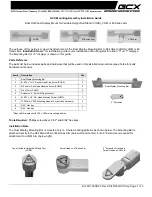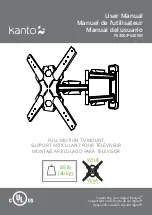
16
44. Digital supply voltage
3.3 V
45. Comb Filter Standard Selection 1
Low Level :
0V
High Level :
3.3 V
46. Comb Filter Standard Selection 2
Low Level :
0V
High Level :
3.3 V
47. Audio Switch Transistor Selection 1
Low Level :
0V
High Level :
3.3 V
48. Audio Switch Transistor Selection 2
Low Level :
0V
High Level :
3.3 V
49. Audio Switch Transistor Selection 3
Low Level :
0V
High Level :
3.3 V
50. Audio Switch Transistor Selection 4
Low Level :
0V
High Level :
3.3 V
51. Tuning output
Low Level :
0V
High Level :
3.3 V
52. Comb Filter PAL-SECAM selection output
Low Level :
0V
High Level :
3.3 V
MSP 34X0D
General Description
The MSP 34x0D is designed to perform demodulation of FM or AM-Mono TV sound. Two kinds of MSPs are used in TV Text PRO.
MSP 3400D and MSP 3410D. The MSP 3400D is fully pin and software-compatible to the MSP 3410D, but is not able to decode
NICAM. It is also compatible to the MSP 3400C.
Features
Demodulator and NICAM Decoder Section
The MSP 34x0D is designed to perform demodulation of FM or AM-Mono TV sound. Alternatively, two-carrier FM systems
according to the German or Korean terrestrial
specs or the satellite specs can be processed with the MSP 34x0D. Digital demodulation and decoding of NICAM-coded TV
stereo sound, is done only by the MSP 3410.
The MSP 34x0D offers a powerful feature to calculate the carrier field strength which can be used for automatic standard
detection (terrestrial) and search algorithms (satellite).
n
two selectable analog inputs (TV and SAT-IF sources)
n
Automatic Gain Control (AGC) for analog IF input. Input range: 0.103 V pp
n
integrated A/D converter for sound-IF inputs
n
all demodulation and filtering is performed on chip and is individually programmable
n
easy realization of all digital NICAM standards (B/G, I, L, and D/K) with MSP 3410.
n
FM demodulation of all terrestrial standards (incl. identification decoding)
n
FM demodulation of all satellite standards
n
no external filter hardware is required
n
only one crystal clock (18.432 MHz) is necessary
n
FM carrier level calculation for automatic search algorithms and carrier mute function
n
High-deviation FM-Mono mode (max. deviation: approx. ±360 kHz)
DSP Section (Audio Baseband Processing)
n
flexible selection of audio sources to be processed
n
two digital input and one output interface via I 2 S bus for external DSP processors, featuring surround sound, ADR etc.
n
digital interface to process ADR (ASTRA Digital Radio) together with DRP 3510A
n
performance of all deemphasis systems including adaptive Wegener Panda 1 without external components or controlling
n
digitally performed FM identification decoding and dematrixing
n
digital baseband processing: volume, bass, treble, 5-band equalizer, loudness, pseudostereo, and basewidth enlargement
n
simple controlling of volume, bass, treble, equalizer etc.
Analog Section
n
four selectable analog pairs of audio baseband inputs(=four SCART inputs)input level:=<2V RMS,input impedance:>=25 KW
n
one selectable analog mono input (i.e. AM sound): input level: =<2 V RMS , input impedance: >=15 KW
n
two high-quality A/D converters, S/N-Ratio: >=85 dB
n
20 Hz to 20 kHz bandwidth for SCART-to-SCART copy facilities
n
MAIN (loudspeaker) and AUX (headphones): two pairs of fourfold oversampled D/A-converters output level per channel: max.
1.4 V RMS output resistance: max. 5 KW S/N-ratio: >=85 dB at maximum volume max. noise voltage in mute mode:
=<10 mV (BW: 20 Hz ...16 kHz)
n
two pairs of fourfold oversampled D/A converters supplying two selectable pairs of SCART outputs. output level per channel:
max. 2 V RMS , output resistance: max. 0.5 KW, S/N-Ratio: >=85 dB (20 Hz ... 16 kHz)
















































